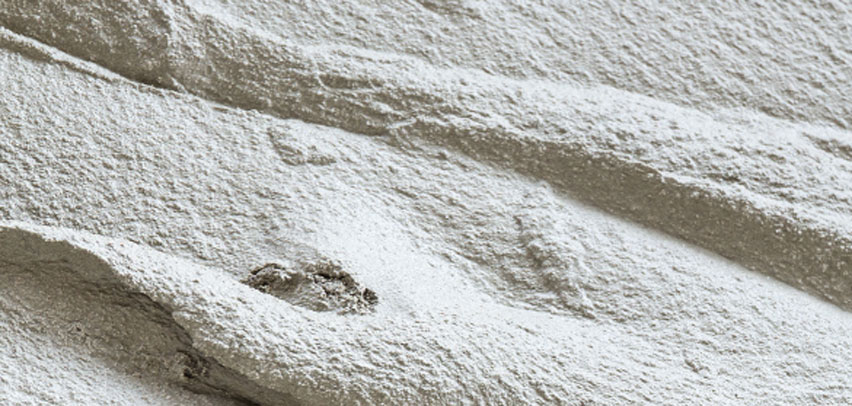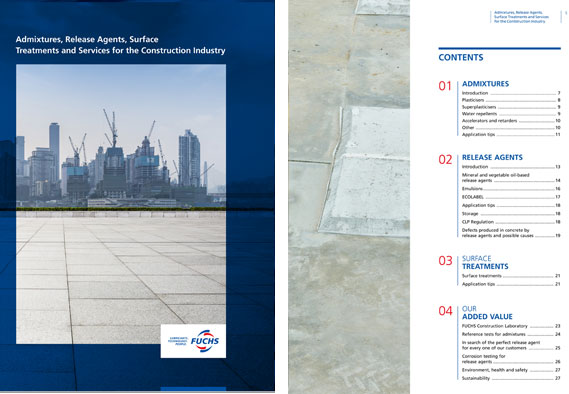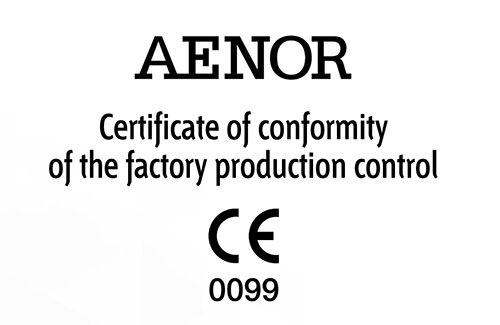Admixtures
FUCHS admixtures have been developed to meet the highest demands of our customers. All our admixtures are CE certified and have a declaration of performance document, if required by the standard.

Admixtures are those substances or products which, when incorporated into concrete, mortar or grout (before or after mixing or during additional mixing), in a proportion not exceeding 5% of the weight of the cement, produce the desired modification in that concrete, mortar or grout in its fresh or hardened state, of any of its characteristics, usual properties or behaviour.
Admixtures for concrete, mortar and grout. Standard: classification and definitions, Prof. Dr. Demetrio Gaspar-Tebar, IETCC/CSIC.
Plasticising admixtures are especially recommended when the sand has few fine components or the cement dosage is weak.
They improve the workability of concrete because they provide greater plasticity in a given water/cement ratio. They allow the amount of mixing water to be reduced by between 5 and 20%, depending on the type of aggregate used.
They help to control setting time in hot weather, as they reduce segregation and the tendency to shrink, resulting in high cohesion and total hydration in the cement, which makes it possible to produce larger and more durable castings.
Dry / semi-dry concrete
TENSIOPLAST PB | Plasticizer for semi-dry concrete recommended for the manufacture of paving stones, blocks and terrazzo. |
TENSIOPLAST OP | Plasticizer for semi-dry concrete recommended for the manufacture of pipes, boxes and lattices. |
BRYTEN AC 600 | Rheological admixture for semi-dry concrete recommended in the manufacture of paving stones, blocks and terrazzo. |
Prestressed concrete
Products especially suitable for concrete intended for the manufacture of prestressed beams and slabs with continuous system machines and for all types of profiles.
TENCEM 2 | Plasticizer and air-entraining agent for prestressed concrete. Product recommended by leading manufacturers of continuous system machinery. |
TENCEM 3 | Plasticizer and air-entraining agent for prestressed concrete recommended for concrete with many fine aggregates due to its dispersing effect. |
TENCEM SP | Plasticizer and air-entraining agent based on polycarboxylates with superplasticizing effect to achieve greater water reduction. |
TENCEM HR | Plasticizer and air-entraining agent based on polycarboxylates to obtain high strength. |
TENCEM NW 20 | New plasticizer for prestressed concrete. Meets ASTM C 494 Type A plasticizing admixture standard. Helps to obtain high strength in a few hours of curing. |
Superplasticising admixtures significantly increase the workability of concrete without the need to add more water during mixing. In mixtures whose workability is already optimal, they also make it possible to reduce the amount of water in the mix to obtain greater final strength.
Fluid concrete
BRYTEN NF | Universal use for all types of applications. |
BRYTEN NF 16 | Recommended for mortars, especially for sprayed applications such as GRC |
BRYTEN NF 20 S | Superplasticizer with retardant effect for mortars and GRC. Suitable for summer temperatures. |
BRYTEN NF HAC | Developed for self-compacting concrete. Ensures a fluid concrete without segregation of aggregates or separation of water. |
BRYTEN NF 25R | Superplasticizer with retardant effect for any type of concrete. Suitable for summer temperatures or if a retardant is needed. |
Water-repellent admixtures increase the waterproof quality of hardened concrete, facilitate the evaporation of water in the curing phases and improve the workability of concrete while maintaining its mechanical strength.
Fluid concrete
BRYTEN L | Concentrated water repellent for concrete blocks, terrazzo and paving stones. |
BRYTEN LX | For semi-dry concrete. Specially recommended for paving stones and medium precast units. |
BRYTEN PREMIUM S2C | State-of-the-art water repellent for all types of concrete. Prevents the appearance of efflorescence. Highly effective and durable. |
BRYTEN H | Developed for self-compacting concrete. Water-repellent powder. Suitable for terrazzo. |
Water-soluble products that act chemically with the concrete, modifying the curing speed, as well as the strength curve.
HORMIDUR F | Chloride-free setting accelerator with high initial strength. Provides greater advancement in the setting curve. |
HORMIDUR SC | Chloride-free setting accelerator that enables production levels to be maintained at low temperatures. |
BRYTEN RF | Chloride-free setting retarder, suitable for summer temperatures or in production situations requiring preservation of rheology. |
BRYTEN IT 125 | Deaerating agent that reduces the air entrapped in concrete. |
BRYTEN IT 250 | Deaerating admixture that removes entrapped air and surface bubbles. |
BRYTEN TX | Thixotropic non-sagging agent for concrete and mortar. Recommended for vertical applications. |
BRYTEN GRC | Polymer admixture for concretes and mortars. Recommended for improving the strength of GRC concrete. |
Here are some application tips for optimizing the use of admixtures in your production processes:
- The dosage of an admixture is always calculated based on the weight of cement in the concrete.
- The proportion to be used must be within the ranges given in the technical data sheet for the product and adjusted according to the results obtained.
- It is always necessary to carry out preliminary tests to adjust the product dose to the concrete in question.
- Liquid admixtures should be added when the concrete already contains part of the water or after mixing, never before.
- Solid admixtures must be previously mixed dry with sand, gravel and cement before adding water.
- The mixing time must be long enough to ensure the product is evenly spread throughout the mix.
- Always keep in mind that, apart from the main purpose for which an admixture is being used, there are secondary purposes or effects that should be taken into consideration.
- If more than one admixture is used, they should not be mixed together beforehand. They should be incorporated into the mixture one after the other, ensuring that one is evenly mixed in before adding the next. The order is determined according to the type of admixture (check with the FUCHS Technical Department).


